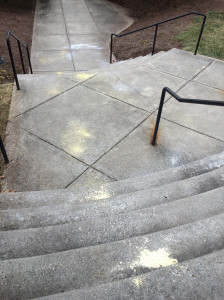Campus glitter is more than just an annoyance

For many years, the Maryville College landscape has been subjected to a variety of changes. From the installation of solar-powered picnic tables to the construction of outdoor classrooms, most of these changes have left the campus better than ever. Unfortunately, some of these changes have done more harm than good.
In the past few years the college has endured the vandalism of its tennis courts, the theft of letters from entrance signs and much more. But perhaps the most peculiar act of defacement comes in the form of shiny, colorful glitter dispersed over the steps of the most frequently visited buildings on campus.
This craft supply – commonly referred to as the “herpes of the craft world”- starts its journey on the steps of buildings such as Thaw Hall and Willard House. Eventually, it makes its way into every nook and cranny of the structure, becoming impossible for cleaning staff to dispel. During the most recent incident, the sparkling material found its way from the sidewalk beside Sutton Science Center and into the carpet of many offices on the ground floor before it was washed away by the rain.
However, in addition to the obvious inconvenience the glitter presents, it is also a surprising environmental hazard.
“The primary problem is that it doesn’t decompose, and everything goes somewhere,” said Dr. Dave Unger associate professor of biology at MC.
MeadowBrook Inventions, Inc. was one of the first companies to begin producing modern glitter, or glitter that is made from a layer of plastic and a layer of metal compounds for shine. As a result of the layering process, the tiny pieces are made even more resistant to decomposition than regular plastic.
Junior Environmental Studies major Ryan Indelicato spoke about how he and his friends view the “glitter problem.”
“Everybody that I talk to agrees that glitter makes our campus look trashy,” said Indelicato. “It also puts a whole bunch of microplastics into the environment that won’t degrade for a long, long time.”
According to the U.S. National Park Service, a single plastic grocery bag could take 10-20 years to decompose, and an aluminum could take an astounding 80-200 years. So when the rain comes to wash the glitter away, it’s washing the tiny reinforced plastic pieces straight into local waterways.
Near the end of 2015, President Obama signed a bipartisan bill banning the sale and distribution of plastic microbeads – tiny beads in body scrubs and toothpastes – due to the need to protect the country’s waterways. One concern was that the microbeads were being mistaken by aquatic life for food, and scientists are currently conducting more studies to determine just how harmful that mistake can be.
According to an article by Michelle Sigler in the environmental science journal Water, Air, and Soil Pollution, “When consumed, microplastics containing plasticizers such as bisphenol A (BPA) and phthalates have been found to affect hatching success and the development and reproduction of offspring in amphibians, crustaceans, and even insects.”
However, some leaders on campus think that these environmental consequences may be unknown to the people responsible for the glitter. Bruce Guillaume, founder of Mountain Challenge, expressed his belief that with knowledge comes a sense of responsibility.
“A lot of bad things can happen because of ignorance,” Guillaume said. “But once you let them know what’s going on…that’s when you can expect a change.”
Guillaume went on to explain the concept of a precautionary principle, the idea that an action with unknown consequences should be avoided.
Fortunately, Maryville College has a long history of environmental stewardship and responsibility, and members of the community like Unger, Indelicato and Guillaume will continue to advocate for these principles. Dr. Unger summed up their perspective nicely.
“Is throwing glitter on the ground a big deal?” he asked. “It might seem like it isn’t. But in the grand scheme of things, you’re only adding on to a problem that already exists – pollution of our waterways – and we don’t need to make it worse.”

